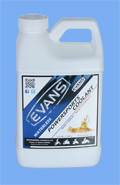
When converting an engine from a water-based coolant to Evans Waterless Coolant (EWC), great care should be given during the installation (conversion) process to insure that all of the old water-based coolant is removed before installing new EWC.
There are a number of methods to use depending on the machine layout and ones mechanical abilities. If you are not comfortable with removing your thermostat and working on the entire cooling system, it is acceptable to drain your system as best as possible, and follow the instructions below.
- Begin with a cold engine.
- All of the old antifreeze must be removed from the cooling system. Conventional antifreeze contains water and water contaminates. DO NOT flush with water. (If the system is badly corroded or contaminated with non-coolant products [i.e. rust, oil, dirt, etc.], you may flush with water and use a chemical cooling system cleaner. More care will be needed to ensure that all the water is then fully removed.)
- Drain cooling system including expansion tank according to the owner's manual.
- If possible, remove a low hose connection, typically at the coolant pump, and blow air in through the radiator or system-fill opening to push out all the old antifreeze. A high-volume air source is preferred over high pressure air. If compressed air is used to help remove the old coolant and water, be aware that it can damage cooling system components. The use of high volume, low pressure air is preferred because it is safer, and in most cases, more effective.
- Close up drains, attach any hoses that were removed, and fill system fully with EWC. Run engine until thermostat opens and fluid is circulated thoroughly. Allow engine to cool to relieve any possible water vapor pressure.
- Drain system and blow out as well as you can again.
- Close up drains, attach hoses, and fill system with EWC. Fill expansion tank to cold line. Check fluid level after initial operation.
Dispose of drained fluid responsibly. Treat EWC the same as antifreeze for disposal purposes.
EWC expands 7% at operating temperature, about the same as antifreeze. If there is no expansion tank on the system, the radiator will purge a small amount upon warm up. Once cooled, this is now the system's operating level.
EWC is a blend of glycols and so it is compatible with the chemicals in antifreeze so that if you must add water to your system in the case of an emergency, the mixture will perform the same as antifreeze and no worse.